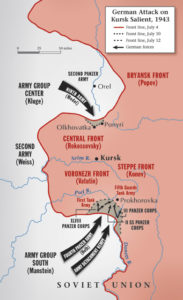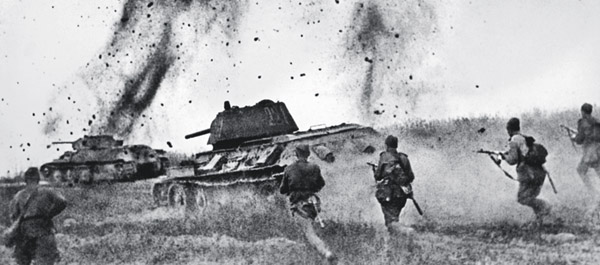“It’s time to write the Last Will and Testament” one SS trooper grimly noted in his diary. Across the line Soviet soldiers swapped morbid jokes—like the one the tanker told about how almost everyone in his unit had been killed that day. “I’m sorry,” he replied. “I’ll make sure I burn tomorrow.”
Everybody knew what was coming. By the summer of 1943 the Soviet offensive that led to the German defeat at Stalingrad in February had run out of steam. German counterattacks had restabilized the front, leaving the Wehrmacht embedded deep in the Soviet Union. The German high command now sought to regain control of the war. During the winter fighting, the Soviets had driven a hundred-mile bulge into the German line around the Soviet city of Kursk, about 300 miles south of Moscow. The Germans wanted to pinch off this salient, then destroy the encircled Soviets in a pattern made familiar during Operation Barbarossa in 1941. A breakthrough at Kursk would shorten the front and draw Soviet reserves onto the guns of a concentration of panzer divisions.
Mounting Operation Citadel, Adolf Hitler and his generals hoped to seize a last, best chance to regain the initiative in Russia before Soviet industrial capacity overwhelmed them and the Western Allies became established in Europe. The Russians, however, foresaw just such an offensive. And they knew it would test their ability to wage a major, intricate combined-arms battle against a first-class, heavily armored, and experienced enemy.

For weeks the Wehrmacht and the Red Army massed men, tanks, guns, and aircraft into and around the Kursk salient. Hitler and the German high command postponed the operation at least twice. Twice the Soviets went on high alert, and twice they stood down.
Then, on the evening of July 4, 1943, the Germans gave a sure clue, issuing a ration of schnapps to each soldier. An Alsatian serving in the SS promptly deserted and convinced an interrogation team—including 49-year-old political adviser Nikita Khrushchev—that the German offensive would be under way before dawn on July 5. So at 10:30 p.m. on the 4th, more than 600 Soviet heavy guns and rocket launchers began blasting German artillery positions and assembly areas.
Over the next 12 days, three-quarters of a million Germans would confront almost two million Russians. Three thousand panzers and more than 5,000 Russian tanks would grapple in history’s greatest clash of armor. The Germans would suffer 55,000 casualties and inflict more than 300,000. Tank losses were even more one-sided—around 250 armored fighting vehicles for the Germans compared to as many as 2,000 for the Russians.
Still, Kursk was a watershed moment. After Operation Citadel, the Soviet Union knew there was no position the Germans could capture or maintain—if the Red Army was willing to pay in blood.
[hr]
This article originally appeared in the Spring 2013 issue (Vol. 35, No. 3) of MHQ—The Quarterly Journal of Military History with the headline: The Crucible at Kursk
Want to have the lavishly illustrated, premium-quality print edition of MHQ delivered directly to you four times a year? Subscribe now at special savings!






